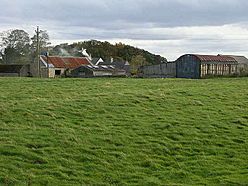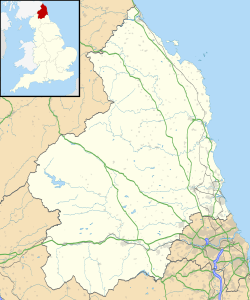Vindobala facts for kids
Quick facts for kids Vindobala |
|
|---|---|

Site of Vindobala at Rudchester Farm
|
|
| Location | |
| Coordinates | 55°00′04″N 1°49′34″W / 55.001°N 1.826°W |
| Place name | Rudchester |
| County | Northumberland |
| Country | England |
| Reference | |
| UK-OSNG reference | NZ112675 |
Vindobala was an ancient Roman fort located in what is now Rudchester, Northumberland, England. It was the fourth fort built along Hadrian's Wall. This famous wall was a defensive barrier in Roman Britain.
Vindobala was positioned about 11 kilometers (7 miles) west of another fort called Condercum. The name Vindobala means "White Strength." Today, the B6318 Military Road cuts right through the middle of where the fort once stood.
Contents
What the Fort Looked Like
The fort was built to protect the valley of the March Burn to the west. This valley was an old path leading south towards a river crossing at Newburn. To the east, the land sloped down towards the Rudchester Burn.
Vindobala was shaped like a rectangle. It was about 157 meters (515 feet) long from north to south and 117 meters (384 feet) wide from east to west. The fort covered an area of about 4.5 acres.
Fort Gates and Towers
The fort had four main gates, each with two entrances. It also had two smaller gates with only one entrance. One main gate was on the north wall. The east and west main gates opened towards the north side of Hadrian's Wall.
This left one main gate on the south wall of the fort. The two smaller gates likely led to a military road running along the south side of the Wall. There were also towers at each corner of the fort. More towers stood on both sides of the main gates.
Surrounding Features
A large ditch and bank system, known as the Vallum, passed about 220 meters (720 feet) south of the fort. A small civilian settlement, called a vicus, grew up outside the fort to the south and southwest.
South of the fort, on a hilltop, there was a large water tank. It was about 3.7 meters (12 feet) long, 1.4 meters (4.5 feet) wide, and 0.6 meters (2 feet) deep. People used to call this tank the "Giant's Grave."
What Remains Today
Not much of the fort can be seen on the surface now. You might spot some mounds south of the Military Road. These mounds show where the west and south walls used to be.
During the 1700s and 1800s, stones were taken from the fort. They were used to build local farm buildings and the Military Road itself.
Who Guarded the Fort?
In the 300s AD, the fort was guarded by a group of soldiers called the First Cohort of Frisiavones. These soldiers came from a tribe living near the coast in what is now Lower Germany.
It is believed that the fort was built for a group of about 500 soldiers. Some of these soldiers would have ridden horses.
Digging Up the Past
Over the years, archaeologists have dug up parts of Vindobala.
Important Discoveries
- In 1760, a life-sized statue of the Roman god Hercules was found at the site.
- In 1924 and 1962, more excavations took place.
- Archaeologists uncovered two of the main gateways.
- They also found a large granary, which was a building for storing grain.
- Part of the headquarters building was also discovered.
- They even found a hypocaust, which was an ancient Roman heating system, from the commandant's house.
The Temple of Mithras
In 1844, five altars were discovered near the fort. These altars were dedicated to Mithras, a Roman god. It is thought that these altars came from a temple to Mithras, located southeast of the fort. This temple is now known as the Rudchester Mithraeum.
The temple was likely built in the 200s AD. It seems it was purposely taken apart in the 300s AD. The building was about 13 meters (43 feet) long and 6.7 meters (22 feet) wide. It had an entrance hall at the front.
Images for kids



